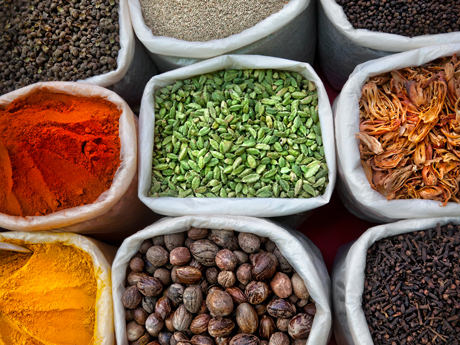Introduction
With a dazzling kaleidoscope of colorful spices and incredible scents, a visit to India is not complete without a stop at one of India’s famous spice markets. Here, you’ll be able to enjoy an authentically Indian environment that has changed very little over the centuries.
This guide will introduce you to six of India’s most famous spices, followed by a list of flawless negotiation techniques that will help you secure goods at a low price.
Masala
One of India’s best-known spices, masala is actually a mix of different spices which differs widely from region to region. That being said, masala generally consists of black and white peppercorns, cloves, cinnamon, black and white cumin seeds and black/brown/green cardamom pods. For best results, grind these together with either herbs or liquids such as coconut milk or water to achieve a pasty consistency. Finally, the spices should be gently roasted to maximize flavor and aroma.
Coriander
Although a common ingredient in many Asian dishes, Indians have their own special way of using coriander. Coriander leaves start to lose their flavor when heated along with the rest of the dish, so most Asian cuisine involves adding raw leaves once the dish is fully cooked. Indians, on the other hand, include large amounts of coriander in the cooking process so they can incorporate the flavor of the leaves into the rest of the dish.
Coriander also has numerous medicinal uses as it is composed of many antioxidants and antibacterial properties. An equally popular use for coriander in India is to boil seeds for diuretic effects.
Lemongrass
Last but not least, lemongrass has a wide variety of uses and is native to India. Its citrus flavor is often used in curries, soups and teas in either powdered or fresh format. Its greatest attribute, however, is its preservative properties – it is commonly applied to ancient palm-leaf manuscripts with its oils keeping the document dry and safe from humidity over time.
Ginger
Ginger is used mainly as a fresh ingredient in vegetable curries and as a dried ingredient in spiced teas. It can even be consumed as candy. It is also a popular treatment for relief from headaches and colds.
Chilli
Although not originally from India – in fact, it was first introduced by the Portuguese in the 16th century – chili is nevertheless a common ingredient in Indian curries and dried dishes. Some states such as Rajasthan even make entire dishes out of this very hot spice.
Jeera (Cumin)
With 70 per cent of the world’s supply and 65 per cent of the world’s consumption being in India, cumin is a significant ingredient that has been used in the country for more than a thousand years. Cumin adds a warming feeling to the dish, and hence is used primarily in stews and soups. It is also a common ingredient in spiced gravies.
Like coriander, cumin also has its medicinal properties. When its seeds are dried and ground into powder, they can become quite useful in treating fevers, gastric problems and lack of appetite.
Negotiating Techniques
Negotiating a price at a spice market in India can be a fun experience if you do it right. Here are some tips on how to get the best price for the goods you want to buy:
- Never reveal how much you would really pay
- Pretend to be indifferent – in effect, act like you don’t necessarily need what you want to buy
- Start the bargaining at one-quarter of the price nor- mally paid for the product
- Don’t go higher than one- third of the actual price
If you don’t feel that confident in haggling – and don’t worry, you’re not the only one – you can always pop into a chain bazaar where spices are well- priced and no negotiations are required. Some even have printed maps so you can easily get around and find what you need.
Most of all, this is a very unique experience. Enjoy and have fun!

